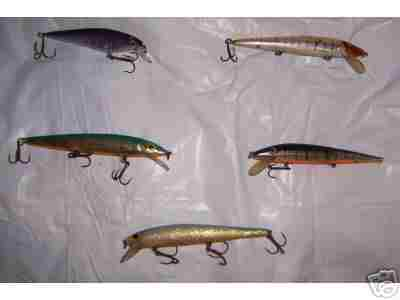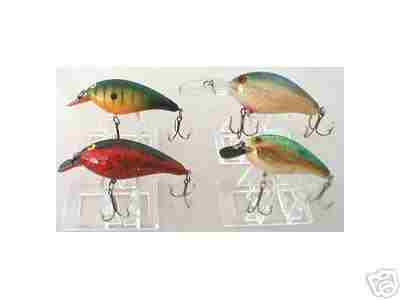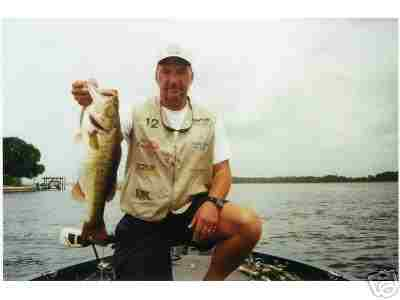Search
Latest Articles
SPRING FISHING FOR BASS
by Bruce Middleton, February 03, 2005
Spring fishing for bass is broken down into three distinct seasons; pre spawn, spawn and post spawn. When spring arrives and the shallow flats begin to warn up, baitfish move up to these flats and begin to feed. Close behind the baitfish are the bass looking for food. They have had a long hard winter and their metabolism is starting to pick up which in turn fires their need to feed. And they feed voraciously. The first move unto the flats is not to spawn as many think, but to feed. Spawning comes several weeks later when the water temperature reaches 65 to 70 degrees. This is called the pre-spawn. Many bass hold out in deeper water, making forage runs into shallow water to feed during the day, then return once they are done feeding. While feeding actively in 3 to 8 feet of water they hold in 12 to 15 feet of water, usually on the edges of creek channels or other deep-water structure.
During spawning the bass have moved into very shallow water to build their nests, lay their eggs, hatch their fry and guard over them. This is when you can see the most bass of the year. This is also when the bass are at their spookiest. They tend not to strike anything if they think it is associated with man, and they are very finicky what they eat at this time.
Post spawn is the most difficult time to fish for bass. They spread out and recover after spawning, staying in heavy cover and eating very little. This period can last up to several weeks, depending on the area, and fishing can remain tough until they have recovered and begin a normal feeding pattern and have established permanent summer homes ranges.
Pre-spawn is an exciting time for all bass fishermen. It marks the time when winter fishing is over and a new year of fishing is beginning. Pre-spawn bass are active feeders and respond to a wide variety of lures and baits. Search baits like crank baits and spinner baits are extremely popular now because they can cover a lot of water in a short amount of time. Worms and plastics are not too often the baits of choice at this time of year because the bass are roaming and not in one place for very long. Shallow cranks that run 1 to 4 feet very popular, along with buzz baits early in the morning. Spinner baits are always used at this time of year. Match the blade size and color to the dominant bait fish in the area for the best results. Usually the blades will be large willow leaf in nickel with white or black skirts. A secondary smaller gold Colorado blade is often a good option to add and the 3/8’s size is the most used.


Popular crank baits used at this time have short square nosed lips for shallow diving. These models are also good around brush and reeds as they are very hard to tangle in the limbs due to their design. Lipless crank baits also work well in shallow water, but you have to work the fairly fast to keep them up in the water column. But they come right out of weeds with a quick jerk, which causes great reaction strikes. Minnow shaped suspending crank baits are probably the best choice of all crank baits use. With the widest variety of presentations, this lure is perfect for more situations than any other crank bait, more times, in more places, than any other crank bait on the market today.
During the Spawn, there are two major ways to fish for bass, blind fishing and sight fishing. Blind fishing will probably land you the most bass but there is nothing like sight fishing to excite and thrill you from the toenails to the top of your head. While you may see 40 or 50 bass and get to interact with each one of them, you will be lucky to catch 3 or 4 of them. But the shear concentration you put into each fish makes time fly by at an incredible rate. After fishing a dozen bass you will swear that only a few minutes have passed when over two hours have elapsed. But just seeing that many bass in clear water, all in one place is amazing, and the size of some of them is incredible, true trophies. And to interact with them whether you catch them or not is so intense. It is truly an amazing time and one you never get tired of.
This is the time for plastics. Yes, you can use spinner baits and other lures with limited success but plastics lands the bass. Texas rigged is one of the most popular ways of presentation but I have found a way that bass just can’t say NO to. Go out and find some ¼ and 3/8 ounce Buckeye jig heads called Spot Removers. They were originally made for taking spotted bass, hence the name spot remover. Anyway, the jig head eye is offset by 90 degrees and the face of the jig is as flat as a pancake. This way when it falls it lands on the flat face with the hook standing up. With a finesse worm of tube on the jig you cast it to the edge of a bass’s bed the drag it to the center. Having a tube or worm standing straight up in the middle of their bed worries a bass to the point that they forget everything and strike it. Works every time. It is an amazing jig. Post spawn is the toughest time of the year to catch bass. Search baits are the key here, look for active bass that spawned early and have recovered form the post partum Blues. Remember that spawning happened of the course of a month or longer and not all bass spawned at the same time. Now is a good time to start looking at shallow cover and brushy areas to see if the bass have moved into these areas as their summer homes, search under docks and the weed beds. Work the lily pad fields thoroughly, and search the bottom for irregular features. Make good maps of the lake.
Start by fishing in the morning with a spinner bait in and near shallow water cover, fishing it right up near the surface even bulging it. Then after several casts, drop it down a foot or two, right down to the tops of the cover or weeds maybe even bumping the cover every now and then. Then go deeper and slower, slow rolling it out around the edges of the grass line or any drop off near the structure. This is a perfect scenario for a compact spinner bait, not weight wise but size wise. Blade shape and size are the most aspects of a spinner bait. Willow leaf blades will go through weeds much better than a Colorado or Indiana blade will. And the size of the blade must match the size of the bait fish the bass are feeding on. In the spring, the baitfish will be full sized so use large sized blades. In the summer the baitfish will have hatched and the average baitfish will be ¾ ers to an inch long and in fall the baitfish will be full sized again. Match your blades accordingly. Large blades, then small, then medium and finally large again as the year progresses, changing blades to meet the changes of the year.
An remember to have a back-up rod ready with a Texas rigged worm or a jig ready for those times that a bass strikes at your buzz bait or spinner bait but won’t come back to it. This back up rod, cast to the spot where the strike happened will catch about 70% of those bass that might normally get away. This is a must have rod and bait combo. It’s like a trailer hook on a spinner bait or a buzz bait, only add one if you want to catch bass. The trailer hook will catch 70 % of the bass.
Rattletrap crank bait in early spring is often referred to as an Idiot bait. Because all you have to do is cast it out and reel it back and it catches bass all day long. A blue/chrome color is great in mostly clear to slightly off colored water. It has plenty of flash and the rattles inside produce lots of sound. It’s idiot proof. It’s just so easy and it’s great for beginners and kids. It doesn’t catch a lot of big female bass but it will haul in a boat of small males. It works best from pre spawn through post spawn.
Spring is just around the corner, so get the boat prepped, new line on those rods. It’s a new year of fishing come a calling.



